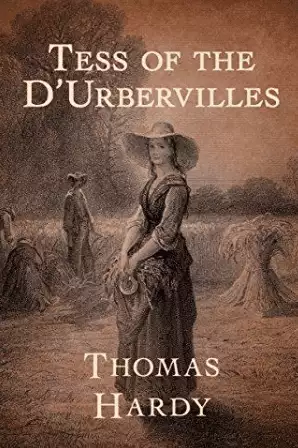Introduction of Tess of the d’Urbervilles
Thomas Hardy’s masterpiece, ‘Tess of the d’Urbervilles,’ stands as a timeless exploration of fate’s inexorable grip on human lives. This tragic tale of a young woman’s struggle against societal norms and cruel destiny continues to captivate readers more than a century after its publication. In this comprehensive analysis, we’ll delve deep into the intricate web of fate woven throughout the novel, examining how Thomas Hardy’s masterful storytelling illuminates the complex interplay between choice, circumstance, and the relentless march of destiny.
Table of Contents
The Inescapable Hand of Fate
Tess’s Ill-Fated Lineage
From the very outset, Thomas Hardy establishes the significance of fate in Tess’s life through her family’s discovery of their noble d’Urberville lineage. This seemingly fortuitous revelation sets in motion a chain of events that ultimately leads to Tess’s downfall. The irony is palpable – what appears to be a stroke of good fortune becomes the catalyst for her tragic journey.
The Fateful Encounter with Alec d’Urberville
Tess’s first meeting with Alec d’Urberville is a pivotal moment that underscores the role of fate in the novel. This chance encounter, orchestrated by her parents’ misguided ambitions, becomes the turning point in Tess’s life. Hardy masterfully illustrates how a single moment, driven by forces beyond Tess’s control, can alter the course of a life irrevocably.
The Prince’s Death: A Harbinger of Doom
The accidental death of Prince, the family horse, serves as a powerful symbol of fate’s capricious nature. This incident not only propels Tess into the path of Alec but also foreshadows the tragedies that will befall her. Thomas Hardy uses this event to highlight the cruel randomness of fate and its far-reaching consequences.
Fate vs. Free Will: A Delicate Balance
Tess’s Choices: Illusion of Control
Throughout the novel, Thomas Hardy presents Tess with moments of apparent choice. However, these decisions are often revealed to be illusory, constrained by societal expectations, economic necessity, and the weight of past events. This tension between fate and free will forms a central theme of the novel, challenging readers to consider the extent of individual agency in the face of overwhelming circumstances.
Angel Clare: A Fateful Love
The introduction of Angel Clare into Tess’s life appears to offer a glimmer of hope and the possibility of happiness. Yet, even this relationship is tainted by fate’s cruel hand. Their mutual attraction, while genuine, is built upon misunderstandings and societal prejudices that ultimately lead to heartbreak and separation.
The Inevitable Return to Alec
Tess’s eventual return to Alec d’Urberville, driven by desperation and familial duty, exemplifies the cyclical nature of fate in the novel. This decision, while made under duress, feels almost predetermined, a cruel twist of destiny that brings Tess full circle to her original tormentor.
Hardy’s Fatalistic Philosophy
Nature as Fate’s Instrument
Hardy’s vivid descriptions of the natural world serve not merely as a backdrop but as an active participant in Tess’s fate. The changing seasons, the harsh landscapes, and the indifferent beauty of nature all reflect and reinforce the novel’s fatalistic themes. The author’s deep connection to the rural English countryside infuses the narrative with a sense of inevitability tied to the rhythms of the natural world.
Social Constraints as Instruments of Fate
The rigid social norms and moral codes of Victorian England play a crucial role in shaping Tess’s fate. Thomas Hardy critiques these societal constraints, portraying them as arbitrary and often cruel mechanisms that trap individuals, particularly women, in predetermined roles and outcomes.
Frequently Asked Questions
- Is Tess entirely a victim of fate in the novel?
While fate plays a significant role, Tess also makes choices that influence her path. However, Hardy suggests that these choices are often limited by circumstances beyond her control. - How does Hardy use symbolism to reinforce the theme of fate?
Hardy employs various symbols, such as the ill-fated horse Prince, the ominous d’Urberville Coach, and the ancient stone monument at Stonehenge, to underscore the presence of fate throughout the narrative. - What role does religion play in the concept of fate in the novel?
Hardy presents a complex view of religion, often portraying it as another form of fatalistic control over individuals’ lives, particularly in the character of Angel Clare and his family. - How does Hardy’s writing style contribute to the sense of inevitable fate?
Hardy’s prose often foreshadows future events and employs a tone of grim inevitability, creating a sense of impending doom that aligns with the novel’s fatalistic themes. - Is there any hope or redemption in the face of fate in ‘Tess of the d’Urbervilles’?
While the novel presents a largely pessimistic view, moments of beauty, love, and personal growth suggest that meaning can be found even in the face of a cruel fate.
The Tragic Culmination of Fate
Tess’s Final Act: Defiance or Submission?
The climactic events of the novel, including Tess’s murder of Alec and her subsequent capture and execution, raise profound questions about the nature of fate and individual agency. Does Tess’s final act represent a defiance of fate or its ultimate fulfillment? Hardy leaves this ambiguity for readers to ponder, adding depth to the novel’s exploration of destiny.
The Stone of Sacrifice: A Symbol of Fate’s Triumph
The novel’s conclusion at Stonehenge, with Tess resting on an ancient stone of sacrifice, powerfully encapsulates Hardy’s fatalistic vision. This final image links Tess’s personal tragedy to a long history of human suffering, suggesting the timeless and universal nature of fate’s influence.
Conclusion: Hardy’s Enduring Legacy
Thomas Hardy’s ‘Tess of the d’Urbervilles‘ remains a powerful exploration of fate’s role in human life. Through its tragic heroine, the novel challenges readers to confront difficult questions about free will, social justice, and the nature of existence itself. Hardy’s masterful storytelling and deep insights into the human condition ensure that Tess’s story continues to resonate with readers, offering a profound meditation on the complexities of fate and its inescapable influence on our lives.
As we reflect on Tess’s journey, we are reminded of the delicate balance between individual choice and the broader forces that shape our destinies. Hardy’s novel, with its rich characterization and unflinching portrayal of life’s harsh realities, invites us to consider our own relationships with fate and the extent to which we can forge our paths in a world often indifferent to our desires.



1 Comment
Pingback: The Mayor of Casterbridge: A Comprehensive Study Guide - LitGram Study